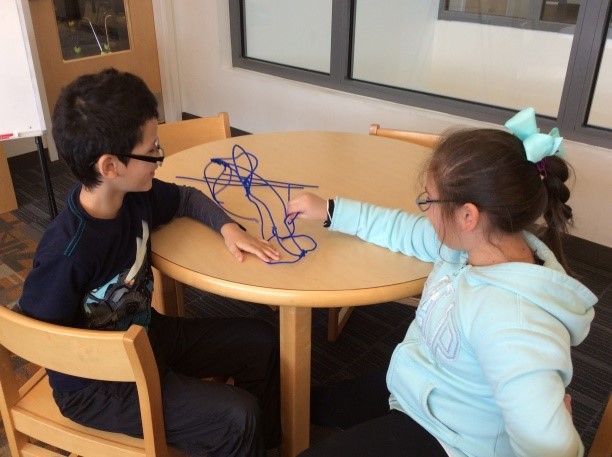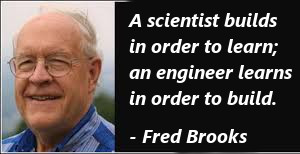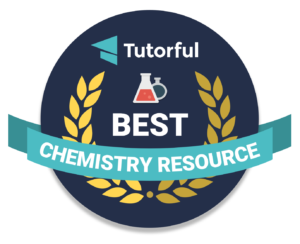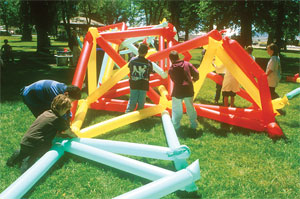 By Cathy Byrne
By Cathy Byrne
This is one of my favorite team-building, icebreaker activities. It’s also a great way to introduce your students to engineering! It can be done with students at many different grade levels. At the beginning of class, I start by welcoming my students to the staff of [Insert-the-name-of-your-school-here] Engineering Company.
I split the class into small groups and tell them: your team has been tasked with constructing the tallest free-standing tower you can build with the materials provided. I give each team a bag containing 20 pipe cleaners and I let them dive right in. It doesn’t take long for the teams to figure out that they need a strong base to hold the flimsy pipe cleaners.
Hang on, engineers!
Now it is time to start adding some unexpected twists…
After a few minutes, I pretend to get a phone call. I ask the students for their attention. “I’m sorry to announce that there have been budget cuts to the project”—which means that I need to reduce the amount of materials they can use. Each group must put five pipe cleaners back in their bags before they continue to build.
A few minutes later, my phone rings again! I inform my students that reducing the materials has not made this project sufficiently cost effective, so I have been ordered to reduce man-power by 50%. To accomplish this, all students may now only use one hand to build. (Their free hands are placed behind their backs.)

There are some giggles and some grumbles, but soon students get back to work. They quickly learn how important communication and cooperation are. Students start to realize they need to articulate clearly what they want to do so their teammates can help them.
At this point, it’s really fun and interesting to watch which groups succeed and which groups struggle. The best communicators are able to keep their build going, while the groups where students don’t communicate well will quickly become frustrated. Think about how much you have just learned about your students!
The plot thickens…
 After giving my students additional time to work together, I get my third phone call. Now I inform my students that management has seen how difficult it is to work with only one hand apiece, so they are increasing man-power. Hooray!
After giving my students additional time to work together, I get my third phone call. Now I inform my students that management has seen how difficult it is to work with only one hand apiece, so they are increasing man-power. Hooray!
But there’s a catch (of course). To keep costs down, many of the jobs have been outsourced overseas to people who do not speak the same language. Students may once again use both hands, but they may no longer use verbal communication. Students may not talk, so they will need to find another way to share ideas with their group. It is amazing how quickly your students learn to adapt and find new ways to communicate. As they work, you are gaining even more insight into your students’ individual strengths and abilities.
Finally, I call for their attention one last time to inform them that:
(1) the project is back on budget,
(2) translators have been hired,
(3) they may continue to build using both hands,
(4) it’s okay to use verbal communication again, and
(5) they are now permitted to use the extra materials from the bag.
But wait… there’s more!
The customer needs these towers quickly so we’ve moved up the deadline. As a result, they only have two minutes left to complete their tower. I set the timer and let them go.
When the bell chimes, I ask all my engineers to put down any remaining materials and step away from their towers. During our debrief, we measure our towers and share our designs. More importantly, we talk about what went well and what got in the way. Students are able to engage in a conversation about the challenges they faced, the steps they took to overcome those challenges, or why they couldn’t succeed.
Bringing it all together
Now it is time to talk about the real-world challenges that engineers, scientists, and business people face every day. I also emphasize that, as students, a big part of their job is to learn how to solve problems so that they are prepared for whatever comes their way.
It is important that students understand the difference between scientists and engineers. According to the University of Toronto, “Engineering is the development of cost-effective solutions to practical problems, through the application of scientific knowledge.” Fred Brooks once said, “A scientist builds in order to learn. An engineer learns in order to build.” Scientists explore the natural world and discover new knowledge about the universe and how it works; engineers apply that knowledge to solve practical problems. As learners, we need to be able to do both.

Over the next couple of weeks, I engage my students in new building challenges using straws, craft sticks, Balsa Wood Bridge Kits, K’nex Bridge Building Kits, and even WindTubes. Each new engineering task offers students the opportunity to use their creativity, overcome new challenges, apply new learning, and refine their engineering skills.
Cathy Byrne is an elementary school STEM coach at the STEM Magnet School in Greenwich, Connecticut. She has taught grades 1 – 5 for 26 years. Cathy now works with teachers to support their implementation of inquiry and STEM lessons. She also teaches STEM classes to grades 3-5, after-school K-5 STEM classes, and is currently helping to create a Tinkering Studio for her school community.



This is a wonderful use of a simple material and shows some of the real life problem engineers run into. I will be using this as my sub-plan!! Thanks so much for sharing!
I am a k-8 science teacher and wanted to thank Ms Byrne for sharing this idea with us. It’s simple, pushes students to think in avenues they’ve not used before-therefore, challenging and most of all HANDS ON & FUN! This was simply great.